| Busan Museum, Busan A diaorama of Ancient Busan at the Busan Museum. | |
 |
HaeDongYongGong, Busan A monk chanting in a temple at HaeDongYongGong Shrine. |
 |
Subway, Busan A buddhist monk from Beomeosa Temple riding on the subway. South Korea has the following religious makeup - Christian 26.3%, Buddhist 23.2%, none 49.3% (1995 census) |
 |
SuYeong Park, Busan Two people playing the game of Go at SuYeong Park. |
 |
YongGaDae, Busan Workers new YongGaDae in the garment industry. |
| Jagalchi, Busan A fish vendor at the Jagalchi Market in Busan, South Korea. | |
| SuYeong, Busan A vendor stall at Su Yeong sells fresh vegetables. | |
 |
PIFF, Busan I am having a bowl of noodles from a vendor at PIFF. |
 |
HaeDongYongGong, Busan A vendor makes a bean filled cookie near HaeDongYongGong Temple. |
| Restaurant, Busan A co-worker makes a hand mint-wrap sushi roll at millak town raw fish center | |
 |
GwangGang Grand Bridge, Busan People fishing. The Gwang Gang Grand Bridge is in the background. |
 |
GeumGang Park, Busan Riders in the Geum Gang Park Cable Car enjoy the view. |
| Busan Taxi Driver in Busan, South Korea. 2,200 Won first 2km, 100 Won/143 m or 34 sec. | |
| Subway, Busan Riders on the Subway in Busan. 3,300 Won for a one-day use. | |
 |
PIFF, Busan Traffic director uses a lightwand to guide automobile traffic. |
| Busan Cultural Center, Busan Performers prepare to play at the Busan Cultural Center. | |
 |
UN Cemetery, Busan A security guard at the UN Cemetery entrance gate. |
| Su Yeong Park, Busan Altar of the 25 Heroes in Su Yeong Park. | |
 |
Beomeosa, Busan The Beomeosa temple complex is at Geumjeongsan. It was constructed in 678AD during the reign of Silla king Munmu, by the monk Uisang. |
 |
Beomeosa, Busan Worshipper at Beomeosa temple complex. |
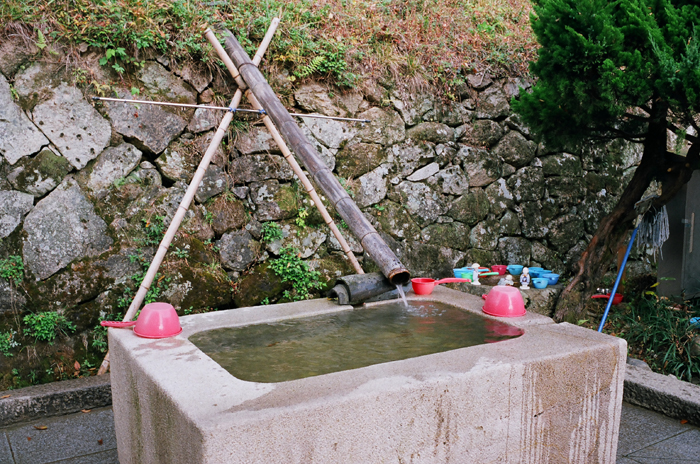 |
Beomeosa, Busan A water reservoir at Beomeosa temple complex. Visitors are supposed to rinse their mouth before entering the temple. |
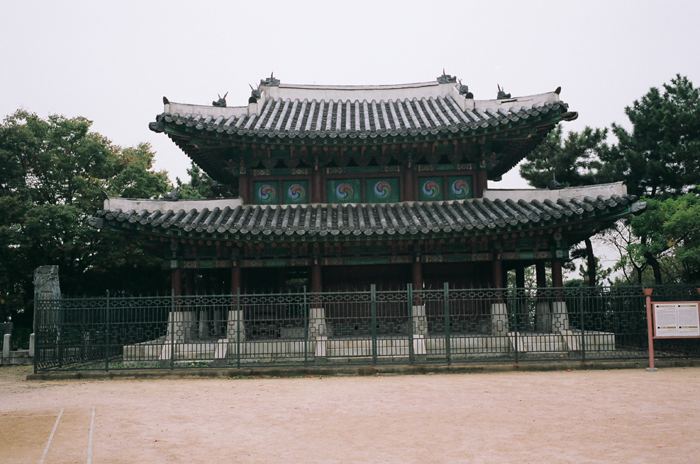 |
Busan Jin Jiseong, Busan Jin Jiseong is a wall-fortress, often call Jaseongdae, was originally a branch wall of the Busan Wall-fortress. The Japanese forces dimantled it, and in its place, built the japanese -style wall-fortress during the Japanese invasions to use it as their command post. Also called Soseoseong (Konisiseong) or Mangongdae, the fortress became to be used by Ming Chinese troops after the Japanese forces withdrew. thereafter, the fortress was repaired and used as a local naval quarters. It had four gates. Inside the wall there were many buildings, including a guest hall, a fortress office and others. Originally sea waters reached just below the wall, but parts of the wall were demolisted in an effort by the Japanese to make room for the extension of Busan city in the early 20th century. Among the remaning structures in the wall-fortress are included two gates- Jindongmun (east) and Geumnugwan (west). The Jinnamdae pavilion was built in the reconstruction project begun in 1974. A two-tiered wall was build by the Japanese during the Japanese invasions, a stele was erected in memory of Ming chinese General Chien by his descendants, and a monument was dedicated to Cheo Yeong, general of the late Goryeo Period. |
 |
Chungnyeol, Busan The Chungnyeol Monument - It is believed that thousands of unkown soldiers found couragously and died for their nation during the Japanese invasion of Korea. This monument 28.6 meters high symbolizes public resistance against the Japanese. Six figures in this monument Civilian, Adminstrator, Soldier, Signal Officer, Bugler, woman represent the resoluteness of defending Korea |
 |
Chungnyeol, Busan The Chungnyeolsa Shrine is dedicated to patriotic Korean fighters who died resisting the Japanese agressors during the Japanese invasion of Korea (1592-1599). The Japanese invasion was an aggressive war through which Hideyosi Toyotomi, who had unified the feudal domains of Japan, attempted to satisfy his desire for a wider territory and for a more stable political regime, at that time, unprepared Korean troops, joined by volunteers, fought and died heroically in battles against the numerically superior Japanese troops armed with advanced matchlock guns. In 1605 (the 38th year of the reign of King Seonjo), the songgongsa(shrine) was ordered built by the then governor of Dongnae, Yun Hwon, within the South Gate of Dongnae Castle in memory of the late Governor Song Sang Hyeon. In 1624 (the 2nd year of the reign of king Injo), this shrine was officially named Chungnyeolsa at the suggestion of Lee Min-gu, Another noted warrior, General Jeong Bal, was enshrined here in the same year. In 1652 (the 3rd year of the reign of King Hyojong), Chungnyeolsa was moved to where it stands today, A lecture hall and several dormitories, called Allakseowon, were built to facilitate the handing down of the ancestors' loyalty and scholarship. This shrine thus served not only as a shrine itself but also as a lecture hall. |
 |
Chungnyeol, Busan In 1709 (the 35th year of the reign of King Sukjong) , an auxiliary shrine was built at the original place of Songgongsa in memory of those who perished together with Governer Song Sang-Hyeon, and General Jeong Bal. Those enshrined in the auxiliary shrine were Jo Yeong-Gyu, No Gae-Bang, Mun Deok-Gyeom, Yang Jo-Han, Song Bong-Su, Kim Hui-Su, Shin Yeo-Ro, Song Baek, and Kim Sang. In 1736 (the 12th year of the reign of King Yeongjo), those to whom the auxiliary shrine was dedicated were also enshrined at Chungnyeolsa. In 1772 (the 48th year of the reign of King Yeongjo), Yun Heung-shin, the genera lof Dadae, was enshrined. In addition a table hall was also built in the same year outside the East Gate in memory of Geumseom and Achyang, who were killed after the death of Governor Song Sang-Hyeon, and General Jeong Bal. Chungnyeolsa has been repaired several times since then and now sits on a site of about 93,399 square meters with a main hall and 15 subsidiary structures. It also has memorial tables of '92 patriots who lost their lives in the Busan area. in the spirit of patriotism, every year on May 25, a memorial ceremony is held. |
| DongBaek Park, Busan In Dong Baek Park sits the statue of Go-Woon Choi Chi-Won, born on the Nam Churn River in Kyungju in the first year of King Hurn-An of the Silla Dynasty in 857AD at 12 he went to study in China. At 18 he passed the state exam and became an official of the government. At 25, he suppressed a rebellion roused by Hwang-So. As a result he was granted a government post named Si-Ur-Sa and Ja-Kum-Ur-Dai, and his having the greatest glory and the highest spirit that any foreign student had ever had. At 28, he returned to Korea and became an official of Si-dok. This caused others to become jealous of him. As a result, he degraded to work as an government official of Tae-Soo of such districts as Tae-in, Sur-San, Ham-Yang. leaving a great essays and poems behind him. Though they gained a government post of A-Chan by appealing to the King the urgency of clean politics, he continued to make upright the fast of his declining country for nothing. Finally he gave up his post. At 40 he began to wander all over the country, taking his family with him at last into Mt. Ga-Ya (in Hap Churn) to cultivate his moral sense. After that, nobody knows where he went, leaving only his Got (Korean hat) and his shoes behind him in the woods. At the time of the Koea Dynasty, they had great respect for him as the Father of He Dong Yu Hak (Korean Confucianism) and the King granted him posthumous title of Mun Chang Hu appraising his highest morality and achievemtns of literature. | |
| DongBaek Park, Busan One of the buildings at DongBaek Park at the summit of a hill. | |
 |
DongSamDong Shell Midden Museum, Busan At Yeong-do Island in Dongsam-dong, Yeongdo-gu, Archaeological site of a midden of shells of mollusk discarded by people who lived there in the Jeulmun Pottery Period. It is among oldest Jeulmun middens so far discovered in the southern part of the Korean peninsula. Yunggimun pottery indicates the site was occupied for a time between 8000-7000 BC, but many absolute dates generated from carbon that was excavated from the site indicate the site was also occupied in the Middle (c. 3500 BC) and Late (c. 2000 BC) Jeulmun sub-periods. three types of pottery (patternless, comb-patterned, and applique patterned), and tools made of bone and stone were uncovered. Artifacts of Dongsam-dong provide insight into the way the people of the area lived as well as into the cultural trends of the times. |
 |
HaeDongYongGong Temple, Busan The motto of Haedong Yonggungsa Temple is "At least one of your wishes will be answered here through your heartful prayers." This seaside temple is situated along the coast of Busan. The Haedong Yonggungsa is situated near the sea unlike other Buddhist temples which are located in mountains. Therefore, it's quite reasonable to call this temple an aquatic Buddhist sanctum. They say that the Great Goddess Buddha of mercy in the sea lives alone in solitary near the sea and appears on the back of a dragon. That's why the Korean's worship of the Great Goddess Buddha was formed near the sea or on an island. The Haedong Yonggungsa Temple is one of 3 Sacred Places related to the Goddess Buddha. This temple preserves religious concept deeper than that of any other temple ever as the sea, dragon and the Great Goddess Buddha embody a harmony here. Haedong Yonggungsa, is the southern most temple near the east sea was founded by the great monk Naong, who was the consultant of King Gongmin. While he was practicing asceticism at Bunhwangsa temple in Gyeongju, the nation was hard hit by a draught that made the crops burn to death and people suffer from famine, so people were disturbed badly resenting the god for not giving them rain. One day, a sea god appeared in Naong' dream and said that if they built a temple at the edge of Bongrae mountain and prayed there, all these hardship would go away leaving people back in happiness. After that dream, Naong visited the area where the Haedong Yonggungsa is located now, and saw that there was a mountain in the front and the sea at the back, which means if they say prayers in the morning they get answered in the evening. He built a temple later called Bomunsa temple by him and named the mountain Bongrae. The word “Bongrae” means something mysterious and pure to which hermits with great understanding descended. The word Bomunmeans the absolute and limitless power of the Great Goddess Buddha of mercy, called Gwanseumbosal in Korean. Unfortunately the temple was destroyed by fire when the Japanese invaded Korea and the monk Ungang of Tongdosa temple rebuilt the temple in the early 1930's. Since then many head monks managed the temple until the monk Jungam prayed that the temple recovered as the Great Goddess Buddha's seminary. Amidst his 100-day pray session he witnessed the Great Goddess Buddha in white robe on the back of a dragon emanating five-color beam and after the dream he renamed the temple Haedong Yonggungsa. They believe that at least on of their wishes will be answered if they pray here and because of that belief many people visit this temple. |
| JwaSuYeong, Busan Jwasuyeong is the main fortress site of Gyeongsangchwado naval forces during the Joseon period. 7 Naval ports with 65 battle ships and 40 auxiliary vessels were under its command and charged with the defense of the east coast area. The command post was first located at Busanpo, then relocated to Gaeunpo in Ulsan, and immediately before the Japanese Invasions of 1592, was moved to this place. It was moved to Gammanipo during the reign of King Injo (1623-1649) and moved back here in 1652, the third year of the reign of King Hyojong (1649-1659). thereafter, it remained at this site, until the naval forces were disbanded in the overall reformation of the military systems in 1895. The time of the original construction of the wall-fortress here is not known, but the wall-fortress to which the existing remains belong seems to have been built after the relocated of the headquarters to this place in 1652. At that time, the wall-fortress was 27xx meters in circumfereance and 4 meters in height. It had 3 wells, 4 gates, 4 drain outlets and a number of small bulwarks along the wall. Most of the facilities have been ruined due to the lack of proper care during the Japanese Occupation (1910-1945) and there remain only parts of the wall, the arched south gate and drain outlets. | |
| Shrine of Ahn Yong Bok, Busan General Ahn Yong-Bok, a fisherman and naval officer during the reign of King Sukjong (1675-1720) of the Choseon Dynasty, was born in Dongrae, near the present site of Suyeong Dong of the Suyeong District. During this period Japan laid claim to the islands of Uleung-do and Dok-do. The renamed both islands Jukdo and frequently invaded them. As a result, Ahn Yong-bok and a group of soldiers went over to Japan and reclaimed both islands as Korea's. They also met with Shogun Edo and settled a treaty stating that Japan would never invade Korean territory again. For his great achievement in guarding Uleung-do and Dok-do he received the rank of General. To commemorate his great achievement, Suyeong District erected this shring and statue, March 26 2001 The district was moved and refurbished the Tower of Patriotism which was built on the peak of Suyeong Park in 1967 to this site. | |
 |
YongGaDae, Busan In 1614, Gyeongsang-do official Kwon Ban established an 8 angle pavilion on the hill formed by the soil from construction sites of wharves on the seaside near Jaseong-dae. In 1623, Seonwe-sa Lee Min Gu named the place as Yongga-dae after Youngka, the hometown of Kwon Ban. Yongga-dae was used for a religious service for the god of the sea to pray for the safety of Tongshinsa, the cultural mission of chosun heading towards Japan. Oh Yun Kyeom was the first envoy to drop in at Yuongga-Dae to pray for the saftey in the 9th year of Kwang hae (1617). Since then groups of envoys had dropped in on their way to Japan until the 11th year of King Sun Jo (1811). However, the place was demolished for railway construction and harbour. Reclamation in 1910's, and then was rebuilt on 25th of September in 2003. Yongga-dae is now considered as a very important subject for Korea's past diplomatic relations with Japan. |
 |
Geumjeongsanseong - Geungjeong Mountain Fortress, Busan After the Japanese invasions of 1592 and the Chinese invasion of 1636 awareness of the necessity for national defence was heightened, especially against attacks from the sea. As a result of this awareness, this fortress was built in the 29th year (1703) of the reign of King Sukjong. the inner and outer walls were mainly built of natural stones, but weak portions were reinforced with artificially worked square stone blocks. The walls are about 17 kilometers in length and from 1.5 meters to 3 meters in height. The area surrounded by the fortress is about 8.2 square kilometers. the fortress was destroyed during the Japanese Occuptation (1910-1945), but began to be restored in 1972. The east, west and south gates were restored by 1974 and the north gate was rebuilt in 1989. It is obvious that fortresses had been already built on this site before 1700. Yi Jihyeong, a naval commander, left a record in 1667 in which he mentions traces of an old fortress on this site. The construction of the fortress began in 1701 at the recommendation of Jo Taedong, the governor of Gyeongsangdo province, and was completed in 1702. In 1707 the walls were built around the main structure of the fortress. This fortress fell to disuse because it was too large to maintain. After lying empty for a century, it was repaired in 1807, the seventh year of the reign of King Sunjo. O Hanwon, the Dongnae Magistrate, took the responsibility for building the west gate in 1807, and the other gates in the following year. There is a stele recording the building of the gates. |
| Lotte Department Store, Busan South Korea is a very technologically advanced country with all of the conveniences that come with a typical capitalistic society replete with a host of huge modern shopping complexes. | |
| Nurimaru APEC House, Busan Nurimaru APEC House is evaluated as the most beautiful place among the meeting places during the APEC Leaders' Meeting on Dongbaek Island. It is the place where the 2nd APEC Leaders' Meeting, Leaders' Luncheon, and the Official Photograph took place during APEC 2005 KOREA. The leaders of APEC's 21 member economies announced the "Busan Declaration" here on November 19, 2005. The name "Nurimaru" is the combination of two purely Korean words: "nuri" meaning the world and "maru" meaning summit. Thus, "Nurimaru APEC House" means "the house where world leaders gathered and held the APEC Leaders' Meeting." world leaders are brought together spirit of openness and cooperation, the guiding spirit of APEC. * The shape of the roof is a representation of the curves of Dongbaek Island. 12 inclined columns represent Dynamic Busan. Korea's creative traditional culture is visualized in its interior design. | |
 |
Bexco, Busan Busan Exposition and Convention Center. In March, 2000 the completion of the framework was done. In January 2001, the name was changed from PUEXCO to BEXCO. In May 2001, the construction of BEXCO was completed. September 2001, BEXCO opened. November 2005, Bexco holds the APEC (Asia-Pacific Economic Cooperation) Summit. |
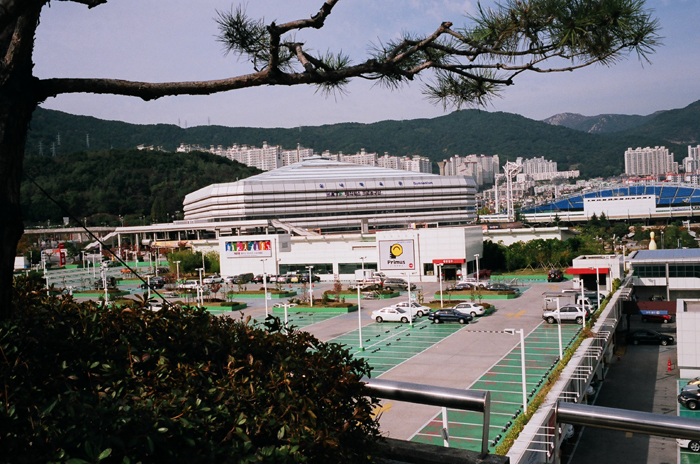 |
Busan Asaid Main Stadium, Busan The gymnasium of the Busan stadium complex. |
 |
Busan Asaid Main Stadium, Busan The Busan Asiad Stadium or Asiad Main Stadium is a the primary stadium in Busan, Republic of Korea. The stadium was built for the 2002 Asian Games and was also used for matches in the 2002 FIFA Soccer (Football) World Cup. It has a total seating capacity of 53,864. It has a main and secondary stadium. The Stadium also hosted the opening and closing ceremonies of the 2002 Asian Games, and was also the site of athletics events during the Busan Asiad of 2002. It is the home stadium for Busan I'Park of the Korea Professional Football League (K-League). The stadium was one of the venues of the 2002 FIFA World Cup. The general stadium complex has a Gymnasium and Baseball stadium. |
 |
Busan Asaid Main Stadium, Busan The interior of the Busan Asaid main stadium. |
 |
Busan Citizen's Hall, Busan The Busan Citizen Hall is divided into the Great Auditorium (No. of Seats: 2,020), the Small Auditorium(No. of Seats: 450), the Exhibition Hall(the 1st Gallery & the 2nd Gallery), the Practice Hall and the Banquet Hall. The place annually opens various events including concerts, theatrical performances, dancing events and movie screenings among many others. The Busan Citizen's Hall was officially opened on October 10, 1973. It serves as a center of cultural events, for regional culture. |
| Busan Cultural Center, Busan The main theater opened in 1977. In 1993, with several smaller theaters were added, along with an art gallery, music room, performance stage, and other exhibition areas. The main theater seats over 1,600 people, while the medium- sized one seats 886 and the small-sized one has room for 249 people. | |
 |
Busan Museum, Busan Opened in 1978, the Busan Municipal Museum exhibits cultural assets dating from ancient times. It aims to improve people's understanding of Korean culture and to provide data for professional researchers. It preserves the results of academic researches and the remains revealed during these studies related to Busan. Busan being one of the oldest cities of Korea has invaluable collections of materials from prehistoric times. And the famous Busan Museum is the place, where those fascinating archeological relics, paintings, ceramics, and other cultural assets are preserved as well as exhibited. The Busan Museum, which was built with the purpose of preserving the history and culture of Busan was opened on September, 1978. Along with rest rooms, lounges, souvenir shops etc. the Busam museum has several exhibition halls, which are divided into Permanent exhibition halls and planning exhibition halls depending on the nature of contents they possess. The 6 Permanent exhibition halls are to display same contents all the time. Dongsam-dong Shell Midden exhibition hall, displaying major sites of Korean Neolithic Culture is one of the important permanent exhibition halls. The halls displaying the remains found in the extraordinary Bokcheon-dong Tombs provides significant information about the Korean and Japanese culture. In the Planning exhibition halls, exhibitions are planned to show contents of a particular age or field, locality etc (for example exhibition of the ancient Egyptian civilization.). The major excavation sites of the Busan Museum are Deokcheon-dong old tombs, Nopo-dong old tombs, Dugu-dong Imseok(wooden stone) site, Gadal old tombs, Mandeok-dong field of death, Danggam-dong ruins of a fortress, Haeundae Paleolithic site, Guemdan-point Boseongji, Cheonggangli tombs, etc. To promote cultural development and research activity Busan Museum does scientific and cultural research and publishes research reports on the excavated sites and widely distributes among different researchers, libraries, experts and other related museums. |
 |
Choryang Foreign Shopping Area, Busan The Choryang Foreigner Shopping Area. On August 1884, the Chung nation in china established a consulate of School of chinese Emigrants in the Choryang area in Busan. A residential and commercial complex for Chinese emigrants was established in the Choryang area in Busan. The street was originally called Chung-gwan street. The name of the street has its origin from the fact that there was a consulate of Qing Dynasty on Choryang 1-dong, Street No.570-8, established in 1884. |
 |
GeumGang Park, Busan Geumgang Park is located at the foot of Geumjeong-san on the Dongnae-gu side. Strange rock formations, rock cliff faces, and a thick pine forest make a strikingly beautiful scenery. A cable car runs to the top of the mountain. In the park one finds historic sites such as Dokjindaeamun, (the site of the inner gate of ancient Dongnae Castle), Mangmiru gate tower, Imjin Dongnae Soldiers Tomb, a zoo, botanical garden, world sea life exhibition hall, and other amusement facilities. |
 |
GeumGang Park, Busan The view of a Cable Car ride in Geum Gang Park. |
 |
GeumGang Park, Busan Cable Car ride at Geum Gang Park goes to the top of Geumjeong-san Mountain. |
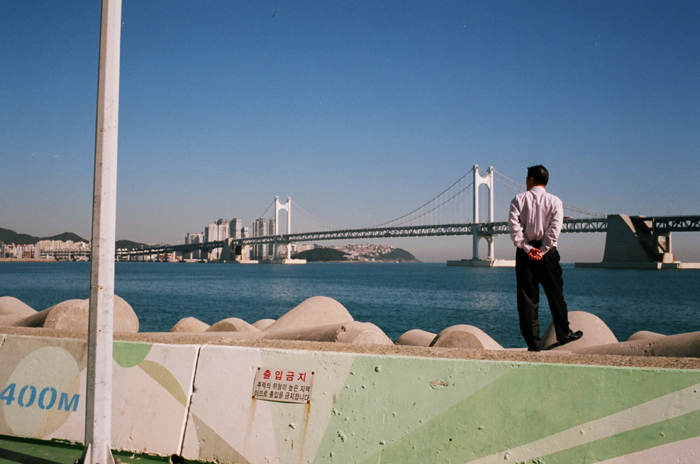 |
GwangGang Grand Bridge, Busan The Gwangan Bridge is a suspension bridge located in Busan, South Korea. It connects Haeundae-gu to Suyeong-gu. The road surface is about 6,500 meters long, with the bridge as a whole spanning 7,420 meters. It is the longest bridge in the country. Construction began in 1994 and concluded in December 2002, with a total cost of 789.9 billion won. The bridge opened temporarily in September and October 2002 for the 2002 Asian Games. However, it was not officially opened until January, 2003. |
| Haeundae Beach, Busan Haeundae Beach is One of the most popular summer destinations in South Korea. Haeundae attracts tourists from all around the country, and gets overcrowded in late July and early August. There are numerous hotels nearby. The Busan Aquarium - South Korea's largest at 13,000 sq. meters is beside Haeundae Beach. Besides the beach, there are some excellent restaurants, both Korean and non, in the area, and a wide variety of shops. The streets behind the beachfront boulevard hides a wonderful market. Many showings and events for the Pusan International Film Festival (Pusan, not Busan) are in this area which typically runs the first 10 days in October. | |
 |
Jagalchi, Busan Ja-galchi Fish Market. This Jagalchi Fish Market is a sprawling market exploding with fish for sale. The Jagalchi fish market had made Busan is famous. This market displays freshly caught fish and various other sea creatures that are still alive. Restaurants are on the 2nd floor of the main multi-storied fishing complex where you can eat fish you've picked out from the first floor. The market runs between Ch'ungmu-dong and Namp'o-dong, right next to Busan Harbor. It actually has two main sections: one for fresh seafood, another for dried seafood. The name of the area comes from Jagal (small rocks) and ch'i (a pure Korean word describing villages next to the seashore). Originally, the area had many small rocks. In modern times, a wharf has been built and much of the area is concrete and lined with buildings, so no trace of the namesake remains. Every year, the Jagalchi Festival celebrates the area and its products. |
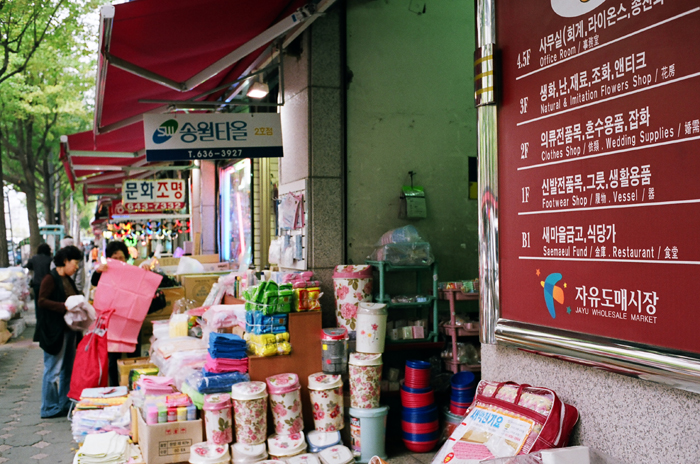 |
Jayu Market, Busan Jayu Wholesale Market. Streets lined with small stores. |
 |
PIFF, Busan The host area of Pusan International Film Festival (PIFF) is crowded with the movie theaters, hand prints of famous movie stars and directors in the sidewalk. Trendy shops are perforated with street vendors. |
 |
Shanghai Gate, Busan The Shanghai Gate in China Town Busan is located across the street from Busan Station. It is also known as Shanghai Street. In 1884, Busan established ties with Shanghai in China and developed a Chinese community by building a Chinese school, residents and a consulate in the area. In this Chinese-style street you can see the Shanghai Gate established by both Busan City and Shanghai City. Mainly packed with many Chinese restaurants, China Town attracts Korean, Chinese as well as many foreign tourists. |
| Su Yeong, Busan Local Market near Su Yeong Park sells a variety of foods. | |
 |
UN Memorial, Busan United Nations Memorial Monument on United Nations Way at Nam-gu district, Busan. It is located at the United Nations Memorial Cemetery. |
 |
UN Memorial Cemetery, Busan The United Nations Memorial Cemetary is located in Busan. The Service Hall of the UN Memorial Cemetery and the Memorabilia Hall were constructed in 1964 and 1968. The Main Gate of the park has been dedicated by the citizens of Busan on 1966. Several annual functions take place here. there are about 11,000 of the UNs brave soldiers laid to rest at this memorial cemetery in the years from 1951 to 1954, |
| YeongdoGu Island, Busan Yeongdo Island. 5.4 sq mile. Pop 163,000. A "Gu" administrative district, Busan. | |
 |
YongDu Park, Busan Rising 49 meters above sea level in the middle of downtown, Yongdusan ("Dragon Head Hill") forms a major landmark much like Seoul's Namsan does. It offers a nice break from the concrete jungle of Korea's second largest city, and people of all ages can be found here, taking a stroll, seeing the sights. Busan Tower sits atop Yongdusan rising 118 meters above sea level. Traditional dance troupes perform on weekends in the courtyard next to the tower. Other notable place of interest include a large oceanarium, bell tower, octagonal pavilion, flower clock, and monuments to naval hero Yi, Sunshin, and independence fighter Ahn, Hui-jai. |
 |
Busan Tower, Busan The observation deck at the top commands a spectacular view of Busan and the surrounding sea. On a clear day, you can even see Japan (Tsushima Island). |
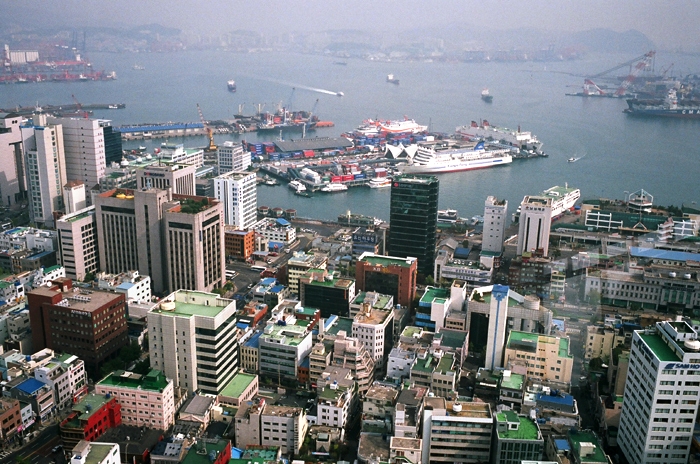 |
Busan Tower, Busan Busan Tower is located in Yandusan Park in Nampodong. It was built in 1973. Busan Tower soars up 393.7 feet (120 meters) above the Busan landscape. It stands on a 226.4 feet (69-meter) high hilltop. This observation tower gives a stunning bird's-eye view of the entire city of Busan including islands and ships dotted in the distant seas. |
| Busan Tower, Busan A view from Busan Tower. Busan has population of 3.65 million (2008). 294.8 sq mi. 15 districts. | |
| SuYeong Park, Busan These are spirit poles at Su Yeong Park. They are actually all over the place and in a number of other sites at Busan. I was there during Halloween which the South Koreans celebrate! | |
| Midorae Restaurant, Busan Plastic model food display of Midorae restaurant. | |
| Restaurant, Busan A plate of Live squirming Octopus tentacles! They taste pretty much how you might imagine live octopus would taste, rubbery. But one of the suckers stuck to my cheek which was a pinching senstation. This caused me to chew it about 100 times. STOP THAT! | |
| Midorae Restaurant, Busan A lunch of Sushi and Curry rice at Midorae in Busan. | |
| Jagalchi, Busan A large crab at Jagalchi Fish Market, in Busan. | |
 |
HaeDongYongGong Sa, Busan Bungtigi (Rice Cake) Machine. Every 8 seconds it shoots out a rice cake. |
 |
HaeDongYongGong Temple, Busan Two Golden Pigs at the sea-side HaeDongYongGong Temple. |
 |
HaeDongYongGong Temple, Busan Golden Buddha at HaeDongYongGong ocean-side Buddhist Temple in Busan. |
| DongBaek Park, Busan A Mermaid statue at DongBaek Park symbolizing the story of Princess Hwangok | |
 |
YeongdoGu Island, Busan Container ship at Yeongdo Gu Island. |
 |
DongSamDong Shell Midden Museum, Busan Shells at DongSamDong Shell Midden Museum of Applique Pottery (6000BC-4500BC) |
 |
PIFF, Busan Bronze handprints immortalize movie actors and directors at PIFF in Busan. |
| Incheon & Seoul, South Korea / June 2024 | |
 |
GyeongBokGung Palace , Seoul, S. Korea Gyeongbokgung Palace was the main and largest of the five royal palaces of the Joseon dynasty. Built in 1395, it served as the home of the royal family and the seat of government. Gyeongbokgung was destroyed by fire during the Imjin War (1592-1598) and abandoned for two centuries. In the 19th century, all of the palace's 7,700 rooms were restored by Prince Regent Heungseon during the reign of King Gojong. 500 buildings were restored on a site of over 40 hectares. Ancient Korean architecture was incorporated into restoration. During World War II, much of the palace was destroyed by Imperial Japan during its occupation of Korea. On January 21, 1963, it was designated as a cultural landmark. Since the 1990s, the palace complex has been gradually restored to its original form. It also houses the National Palace Museum and the National Folk Museum. |
 |
JongChinBu, Seoul, S. Korea Jongchinbu was responsible for the storage and management of royal genealogies, portraits and official clothes of kings and queens of Joseon and various issues related with the royal family and their relatives. It was relocated to Jeongdok Library in 1981. It was returned to the its location in 2013 when the Nation Museum of Modern and Contemporary Art was built. There is a terrace (woldae) in front of Gyeonggeundang Hall and wings (ingnang) link Gyeonggeundang Hall to Okcheopdang Hall. It is a good example of an administrative building of the Joseon era. |
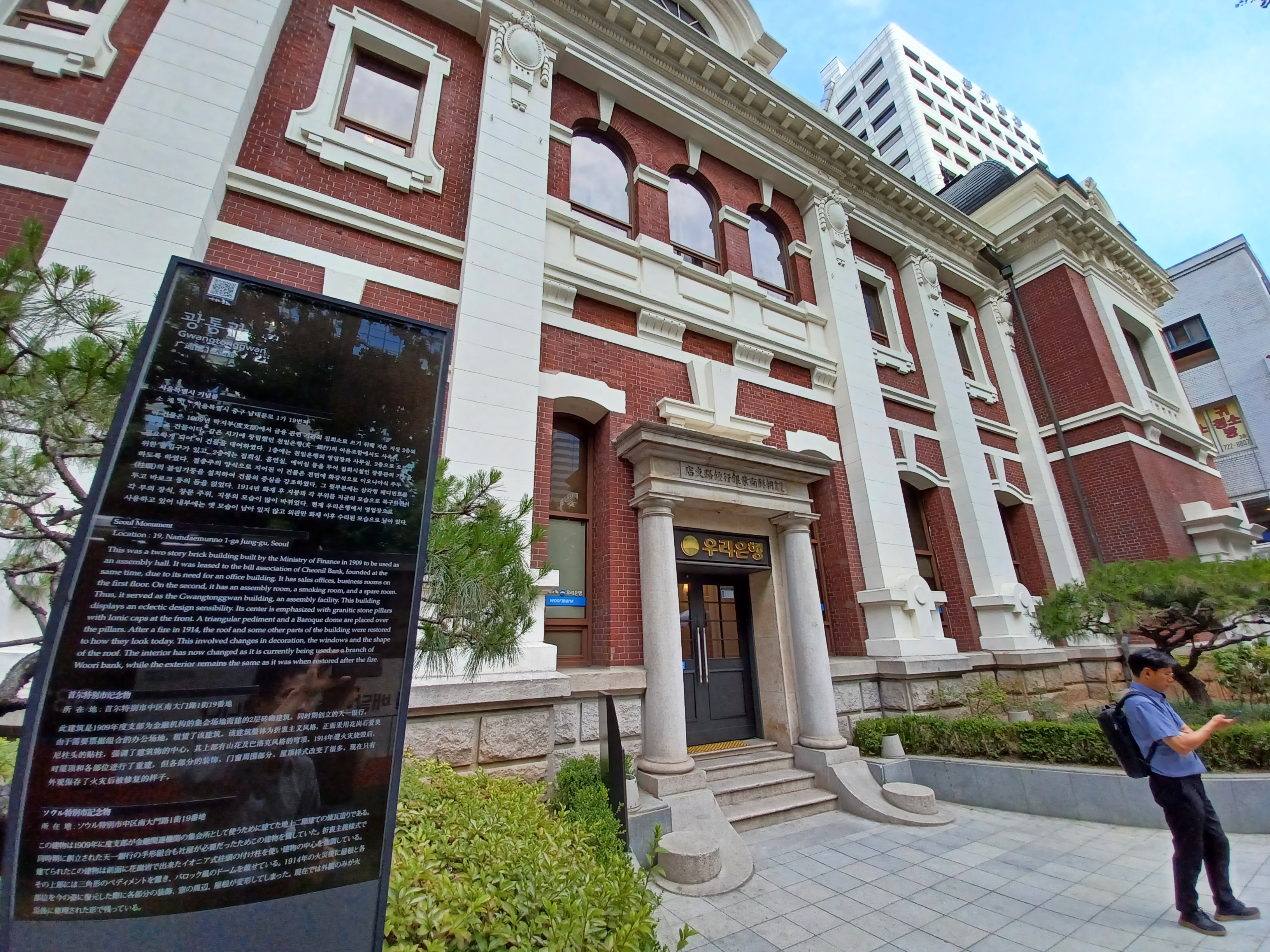 |
GwangTongGwan, Seoul, S. Korea This two-story brick building was built by the Ministry of Finance in 1909 with an eclectic architectural design with its center emphasized by granite stone pillars with Ionic caps. It was used as an assembly hall. It was leased to the Cheonil Bank, founded at the same time, because it needed an office building. It has sales offices and business rooms on first floor. On the second floor, it has an assembly room. It served as the Gwangtonggwan building, an assembly facility. After a fire in 1914, it was restored which involved changes in decoration, to the windows and the roof. The interior was changed during the restoration as it is currently being used as a branch of Woori bank. |
 |
Bosingak Bell Pavilion, Seoul, S. Korea The Bosingak bell pavilion was built in 1396 in the 5th year of the reign of King Taejo in present-day Insa-dong, then the heart of Hanyang, the capital of the Joseon Dynasty (present-day Seoul). It was moved to its current location during the reign of King Taejong (1400-1418). The Bosingak Bell was rung according to Buddhist custom: thirty-three times to announce pant, the opening of the city gates at daybreak and twenty-eight times to announce injeong their closure at night. It was also rung to warn the populace of emergencies. The bell pavilion was originally a larger structure but was destroyed and repaired many times due to wars and fires, and had shrunk by the late Joseon Period. It used to be called Jonggoru but acquired its current name Bosingak in 1895 during the reign of King Gojong. In 1979, the bell pavilion was completely restored to its original size during the reign of King Sejong. In 1985, the Old Bronze Bell of Bosingak Pavilion was replaced with a replica and the original was sent to the National Museum of Korea. |
 |
Arex Train, Seoul, S. Korea The Arex train has an express and local schedule. We took it into the heart of Seoul. The express cost us 11,000 KRW (June 14, 2024 conversion rate 1,350 KRW to $1 USD). It was a direct train with a single stop from Incheon to Seoul (30 miles). It took 45 minutes. The Incheon and Seoul Metro system is an extensive transport system. It consists of 23 rapid transit, light metro, commuter rail lines that serves Seoul, Incheon and satellite cities in Gyeonggi province. Most of the system is operated by three companies: Seoul Metro, Korail (Korea Railroad Corporation), and Incheon Metro. Its first metro line, Line 1, started construction in 1971 and began operations in 1974. |
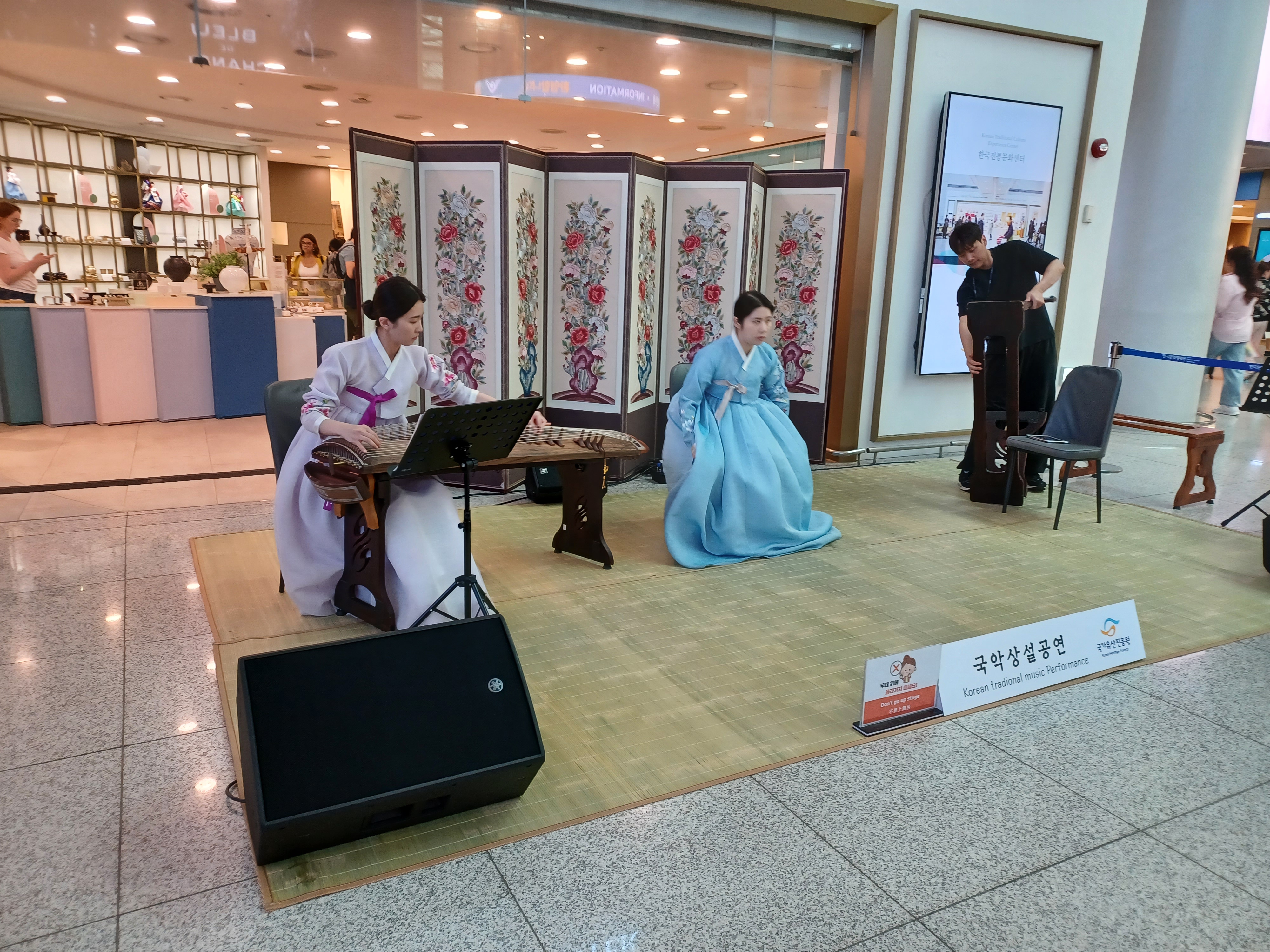 |
Musicians, Seoul, S. Korea These are performing musicians playing traditional Korean Music. The stringed instruments are the Gayageum and Geomungo. You can watch their performances on my YouTube channel |
 |
Mama's Korean BBQ Restaurant, Seoul, S. Korea Mama's Korean BBQ located at 72 Gonghang-ro 424beon-gil, Jung-gu, Incheon, South Korea. This is one of numerous Korean BBQ restaurants that we visited during our trip. We sat on the floor on straw mats. We ordered Bibimbap and also BBQ dishes that were cooked on a charcoal grill in front of us. The wonderful entrees were accompanied by many side dishes that filled our table. |
 |
Bukchon Hanok Village, Seoul, S. Korea Bukchon Hanok Village is a residential neighborhood in Jongno District, Seoul, South Korea. It has many restored traditional Korean houses, called hanok. This has made it a popular tourist destination but has caused friction with the residents who live there. Hence, the workers wearing "Please be quiet" signs. |
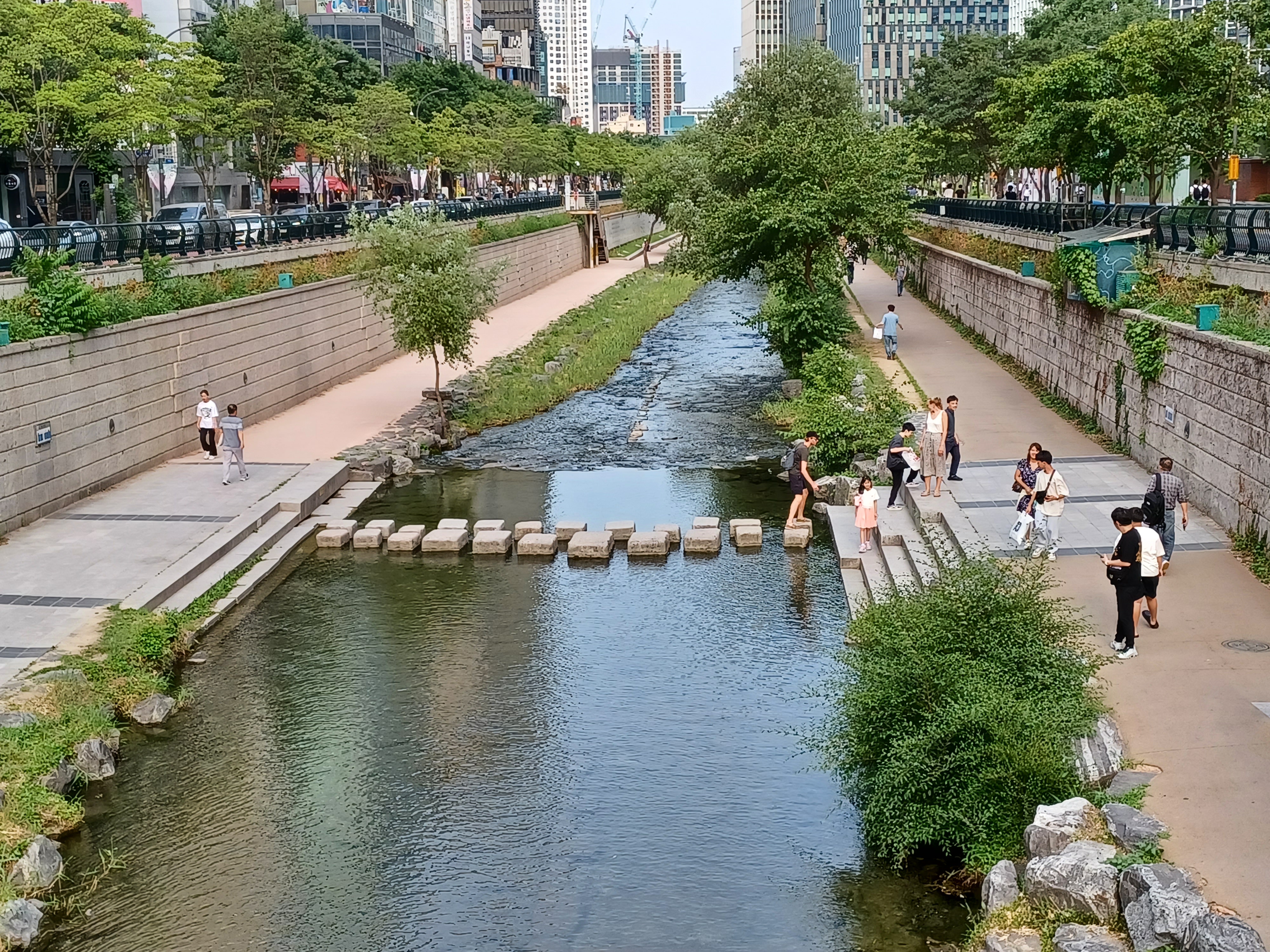 |
CheongGyuCheong River, Seoul, S. Korea Cheonggyecheon is a 10.9-kilometre-long (6.8 mi) stream in downtown Seoul, South Korea. A natural stream sourced from the Suseongdong Valley in Inwangsan, it was part of Seoul's early sewerage until the mid-20th century, when post-Korean War rapid economic development prompted the filling of the stream with concrete replaced by the construction of an elevated freeway, the Cheonggye Expressway. In 2003, the city government began an urban renewal project to disassemble the expressway and restore the stream, which was completed in 2005 at a cost of 386 billion Won (US$281 million). It is popular among residents and tourists. |
 |
Myeong Dong, Seoul, S. Korea A food stall at Myeong Dong selling grilled boneless Chicken feet for 10,000 KRW (with a June 2024 conversion rate of 1,350 KRW = $1 USD) = $7.40. There were food stalls selling Baked Cheese, Fruit Cups, Sausage Corn Dogs, Egg Bread, Kebabs, Handmade Pomegranate Juice, Fried Seaweed Rolls, Gimbap, Kimchi Pancakes, Grilled Squid, Fried Crab, Souffle Cake, Fried Coconut Shrimp, Gyoza, Lamb Skewers, Grilled Abalone, Cheese Kimchi Pork Belly Rolls, Fish Cake, Oreo Churros, Nutella Crepes, Kebabs, Grilled Prawn Skewers and many more specialty stalls. There were also numerous stalls selling various souvenirs, hand-made goods, and products. |
 |
MyeongDong, Seoul, S. Korea Myeong-dong is a dong (neighborhood) in the Jung District of Seoul, South Korea. It is known for being one of Seoul's main shopping, parade route, and tourism districts. In 2023, Myeongdong was listed as the ninth most expensive shopping street in the world. The area is known for its two historically significant sites, namely the Myeongdong Cathedral and the Myeongdong Theater. Performances at the Myeongdong Nanta Theater are popular. It covers area of 0.99 km^2 and has a population of 3,409. |